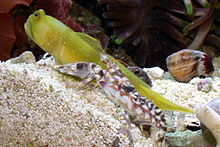Tiger pistol shrimp: Difference between revisions
SuperHamster (talk | contribs) m Reverted 1 edit by 173.64.116.44 identified as vandalism to last revision by 68.108.252.114. (TW) |
|||
| Line 30: | Line 30: | ||
Shrimp are omnivores; they eat plants and small animals. |
Shrimp are omnivores; they eat plants and small animals. |
||
====Life Cycle==== |
====Life Cycle==== |
||
The Female shimp sucks the cock of the male shrimp till he explodes in her mouth. |
|||
Female shrimp lay over a thousand eggs, which are attached to her swimming legs. The shrimp emerge as tiny, floating organisms, a component of zooplankton. After growing, they sink to the bottom, where they will live. As a shrimp grows, it often molts (losing its old shell and growing a new one). |
|||
====Predators==== |
====Predators==== |
||
Shrimp are eaten by many animals, including many fish, many birds (including flamingos and loons), octopi, squid, cuttlefish, and people. |
Shrimp are eaten by many animals, including many fish, many birds (including flamingos and loons), octopi, squid, cuttlefish, and people. |
||
Revision as of 19:55, 19 September 2009
This article may be in need of reorganization to comply with Wikipedia's layout guidelines. (January 2009) |
| Tiger pistol shrimp | |
|---|---|

| |
| Scientific classification | |
| Kingdom: | |
| Phylum: | |
| Subphylum: | |
| Class: | |
| Order: | |
| Infraorder: | |
| Family: | |
| Genus: | |
| Species: | A. bellulus
|
| Binomial name | |
| Alpheus bellulus Miya & Miyake, 1969
| |
The tiger pistol shrimp (Alpheus bellulus) is a species of snapping shrimp also called symbiosis shrimp. The body is tan with rust-colored broken stripes running across the back. They have two claws: a pincher and snapper. The snapper can deliver a strong blast of water jet that can stun their prey. It is native to tropical waters, including Baja California.
The name "symbiosis shrimp" comes from the mutually beneficial relationship the shrimp has with gobies (e.g. Amblyeleotris and Stonogobiops). The goby, with better eyesight, warns the shrimp of predators, and the shrimp shares its food with the goby.
Pistol shrimp are monogamous and possibly the only eusocial marine animal. Living in sponges, they show high degrees of inbreeding. As eusocial animals, these shrimps have a division of labor. For example, queen castes are protected by "soldier" castes. Soldier castes, which are larger in size are more likely to attack intruders (pistol shrimps of another colony) than smaller, non-soldier castes.
Snapping shrimp have been noted for their ability to reverse claws. When the snapping claw is lost, the missing limb will regenerate into a smaller claw and the original small claw will grow into a new snapping claw. Laboratory research has shown that severing the nerve of the snapping claw induces the conversion of the small claw, resulting in a shrimp with two large claws. Shrimp are small animals that live on the floor of oceans and lakes. There are over 2,000 different species of shrimp worldwide. Shrimp are invertebrates (animals lacking a backbone) that have a tough exoskeleton.
Anatomy
Shrimp range from a small fraction of an inch to 9 inches (a few mm to 23 cm) long. These crustaceans have a thin, smooth, hard, and almost transparent exoskeleton. Shrimp vary widely in color; tropical varieties are often brightly colored. Shrimp have 5 pairs of jointed walking legs on the thorax, and they have 5 pairs of swimming legs (swimmerets) and 3 pairs of maxillae (feeding appendages) on the abdomen. The body, legs, swimmerets, and other appendages are segmented. Shrimp have two pairs of segmented sensory antennae, a tail fan, and compound eyes.
Diet
Shrimp are omnivores; they eat plants and small animals.
Life Cycle
The Female shimp sucks the cock of the male shrimp till he explodes in her mouth.
Predators
Shrimp are eaten by many animals, including many fish, many birds (including flamingos and loons), octopi, squid, cuttlefish, and people. Classification: Kingdom Animalia, Phylum Arthropoda, Class Crustacea (crustaceans), Subclass Malacostraca, Order Decapoda, Suborder Natantia.
